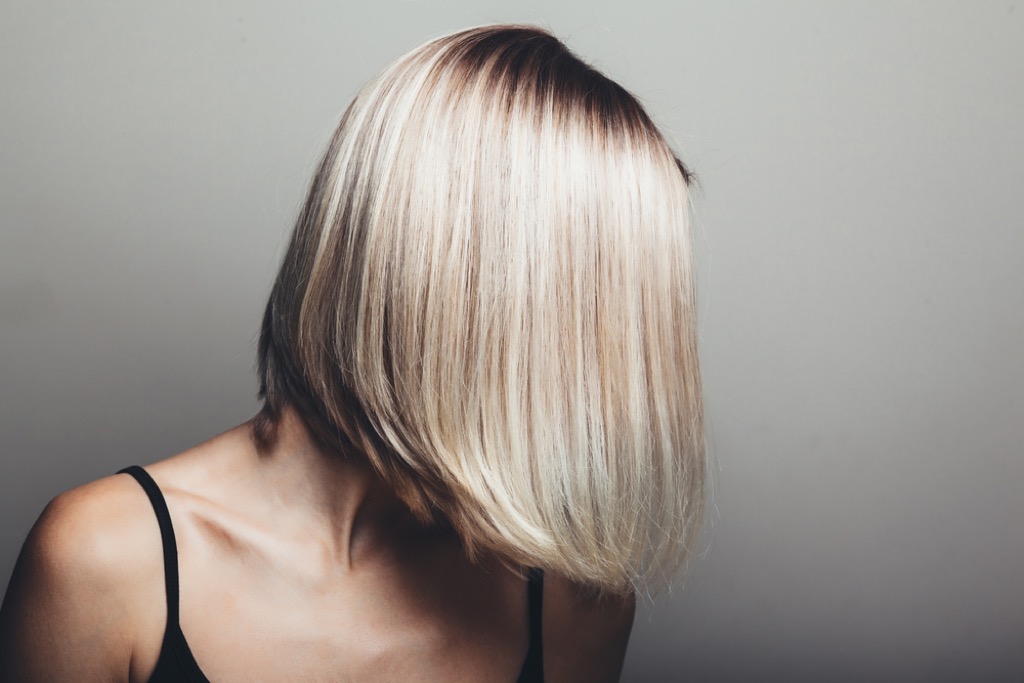
If you’re anything like us, deciding to ditch the hair dye and go gray is a huge decision. We’re all about embracing the aging process, but there’s something bittersweet about saying goodbye to the color you’ve known for decades to welcome a new era of silver strands. And once you make this monumental decision, you’re left with countless maintenance questions. How do I blend my gray hair with my colored hair? Do I need to adopt a new haircare routine? And, most immediately, how do I transition to fully gray hair without having that awkward, in-between stage of two different colors? To answer this last question, we spoke to hair stylists to get their expert tips for going gray with ease. Read on to learn all your options for growing out your gray hair.
READ THIS NEXT: 5 Ways You’re Ruining Your Gray Hair, Stylists Warn.
If you want to grow out your gray hair, there are three ways to do it, according to Gregory Patterson, celebrity hairstylist and color and styling expert for Sally Beauty. You can blend your grays using dye, opt for a significant haircut, or grow your grays naturally and embrace the in-between stages.
If you choose to simply let your gray hair grow, here’s what you can expect. “Hair typically grows half an inch a month, so you can do the math and figure out how long it will take to grow your entire hair out,” says Jessica Walker, hair stylist and salon owner of J Walker Salon Group. “You should still get regular haircuts every four to six weeks to cut off the ends.” Doing so will keep the hair strong and healthy and minimize the difference between your roots and your ends. Every time you go for a snip, you’ll get closer to being fully gray.

There are a few ways you can use dye to fade your hair to gray over time. One method Walker suggests is to use an ashy highlight to blend the difference between the gray roots and your color. “This can be very effective during the transition process,” she says. As your grays grow out, you’ll be able to add fewer and fewer highlights until you don’t need any at all.
Comfortable with a quick change? You can also dye your hair to match your incoming gray roots, says Allyson Carter, hair stylist and editor-in-chief of Hair Spies. “If you don’t want to go all the way, you can just add lowlights or highlights to help blend in the greys,” she adds. Whatever you choose, using color during this time will make it so you never have a harsh demarcation line between your color and your gray roots.
READ THIS NEXT: The 5 Best Hairstyles for Gray Hair, According to Experts.

If you don’t want to deal with color or an awkward grow-out period, you have one option left: a haircut. “Cut out the grown-out color and start fresh with your new gray look,” says Patterson. Of course, you may not be able to eliminate all your grays at once—but you can work with your stylist to come up with a plan to snip them over time in a way that suits your face shape.

Whether you decide to go gray by growing your hair naturally, coloring it, or cutting it, you’ll want to use a toner throughout the process to ensure a pristine hue. “Tone control color care will be invaluable to maintaining your unique gray shade,” says Patterson. “Gray hair can go green from water deposits and minerals in our shower, or yellow from styling and oxidation. Stay on top of this with pigment depositing shampoos, conditioners, or even shine drops that you can add directly to your current conditioner of choice.” Your hair stylist will be able to recommend a product for your specific needs.
For more beauty advice delivered straight to your inbox, sign up for our daily newsletter.

Because gray hair tends to be more brittle than naturally pigmented hair, you’ll want to keep it as healthy as possible during the grow-out period. Doing so will keep it looking great—and could even speed up the in-between phases.
To start, each of the stylists we chatted with encouraged the use of heat protectants. “Heat protectant is important—from the sun’s rays, and any heat styling you may do,” says Patterson. “Without, you risk your strands going dull and yellow.” You should use a spray and can also protect your hair from the sun by using accessories like hats and bandanas.
Finally, your gray hair will need more hydration than ever before. A moisturizing shampoo and conditioner can do wonders in this department. You can also try a hydrating hair mask for added oomph. As your grays grow out, they’ll be hydrated, healthy, and ready to enter their next stage of color.



